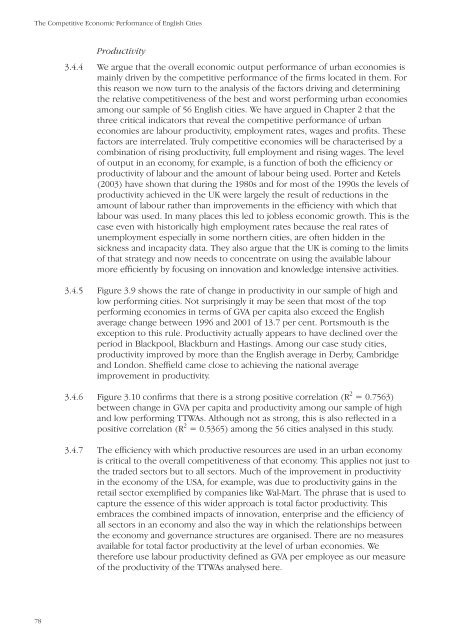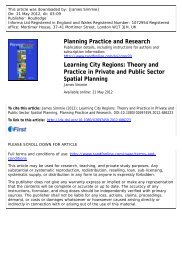The Competitive Economic Performance of English Cities
The Competitive Economic Performance of English Cities
The Competitive Economic Performance of English Cities
- No tags were found...
Create successful ePaper yourself
Turn your PDF publications into a flip-book with our unique Google optimized e-Paper software.
<strong>The</strong> <strong>Competitive</strong> <strong>Economic</strong> <strong>Performance</strong> <strong>of</strong> <strong>English</strong> <strong>Cities</strong>Productivity3.4.4 We argue that the overall economic output performance <strong>of</strong> urban economies ismainly driven by the competitive performance <strong>of</strong> the firms located in them. Forthis reason we now turn to the analysis <strong>of</strong> the factors driving and determiningthe relative competitiveness <strong>of</strong> the best and worst performing urban economiesamong our sample <strong>of</strong> 56 <strong>English</strong> cities. We have argued in Chapter 2 that thethree critical indicators that reveal the competitive performance <strong>of</strong> urbaneconomies are labour productivity, employment rates, wages and pr<strong>of</strong>its. <strong>The</strong>sefactors are interrelated. Truly competitive economies will be characterised by acombination <strong>of</strong> rising productivity, full employment and rising wages. <strong>The</strong> level<strong>of</strong> output in an economy, for example, is a function <strong>of</strong> both the efficiency orproductivity <strong>of</strong> labour and the amount <strong>of</strong> labour being used. Porter and Ketels(2003) have shown that during the 1980s and for most <strong>of</strong> the 1990s the levels <strong>of</strong>productivity achieved in the UK were largely the result <strong>of</strong> reductions in theamount <strong>of</strong> labour rather than improvements in the efficiency with which thatlabour was used. In many places this led to jobless economic growth. This is thecase even with historically high employment rates because the real rates <strong>of</strong>unemployment especially in some northern cities, are <strong>of</strong>ten hidden in thesickness and incapacity data. <strong>The</strong>y also argue that the UK is coming to the limits<strong>of</strong> that strategy and now needs to concentrate on using the available labourmore efficiently by focusing on innovation and knowledge intensive activities.3.4.5 Figure 3.9 shows the rate <strong>of</strong> change in productivity in our sample <strong>of</strong> high andlow performing cities. Not surprisingly it may be seen that most <strong>of</strong> the topperforming economies in terms <strong>of</strong> GVA per capita also exceed the <strong>English</strong>average change between 1996 and 2001 <strong>of</strong> 13.7 per cent. Portsmouth is theexception to this rule. Productivity actually appears to have declined over theperiod in Blackpool, Blackburn and Hastings. Among our case study cities,productivity improved by more than the <strong>English</strong> average in Derby, Cambridgeand London. Sheffield came close to achieving the national averageimprovement in productivity.3.4.6 Figure 3.10 confirms that there is a strong positive correlation (R 2 = 0.7563)between change in GVA per capita and productivity among our sample <strong>of</strong> highand low performing TTWAs. Although not as strong, this is also reflected in apositive correlation (R 2 = 0.5365) among the 56 cities analysed in this study.3.4.7 <strong>The</strong> efficiency with which productive resources are used in an urban economyis critical to the overall competitiveness <strong>of</strong> that economy. This applies not just tothe traded sectors but to all sectors. Much <strong>of</strong> the improvement in productivityin the economy <strong>of</strong> the USA, for example, was due to productivity gains in theretail sector exemplified by companies like Wal-Mart. <strong>The</strong> phrase that is used tocapture the essence <strong>of</strong> this wider approach is total factor productivity. Thisembraces the combined impacts <strong>of</strong> innovation, enterprise and the efficiency <strong>of</strong>all sectors in an economy and also the way in which the relationships betweenthe economy and governance structures are organised. <strong>The</strong>re are no measuresavailable for total factor productivity at the level <strong>of</strong> urban economies. Wetherefore use labour productivity defined as GVA per employee as our measure<strong>of</strong> the productivity <strong>of</strong> the TTWAs analysed here.78













